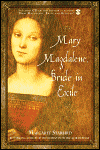
Mary Magdalene is the first lady of the Bible. While Dan Brown may get much of the credit for her current fame—what with the Vatican condemning The Da Vinci Code and nuns picketing the filming of the movie—it’s from Margaret Starbird that Brown got his information. In this newest of her series of books that started in 1993 with The Woman with the Alabaster Jar, Starbird repeats her thesis that Magdalene was the sister of Lazarus and Margaret of Bethany and the wife of rabbi Yehua, whom we know better as Jesus the Christ.
We who worship the Goddess have taken both of the New Testament Marys into our hearts and eclectic modern pantheons. We go to lectures and workshops and art exhibitions and find Mary the Mother and Mary the Wife. We adore them and proclaim them to be manifestations of the Great Goddess. Well, maybe. In “real life,” they were good Jewish women. One gave birth to and the other married an extraordinary Jewish rabbi who had revolutionary ideas about gender equality. Starbird does not say that Magdalene is a goddess. Mary Magdalene is an important, but neglected, Judeo-Christian figure. Because, Starbird writes, the four Synoptic Gospels were written half a century after the events they describe for an audience of Romans and others who were familiar with the old pagan goddesses, Magdalene can be legitimately compared Isis, Sophia (who is also not a pagan goddess), and Asherah. Because Magdalene is the one who anoints Jesus and anointing is what makes him the Christ (“anointed one”) and Bridegroom of the land and its people, she is the Bride of Christ. It’s a familiar myth: the king, representing the land and people, engages in sacred marriage (hieros gamos) with the representative of the Goddess and together they rule the land in peace and prosperity.
Except that in first century Judea, the myth did not play out. The Romans ruled the land and Paul was the Apostle to the Romans, so it was in Paul’s best interest not to mention that Jesus might have had a wife or, indeed, preached any non-Pauline teachings. The Romans ruled the land and would have massacred Magdalene and her family if they had not been hidden away—exiled—so completely that their existence was either forgotten or warped, and the beloved wife became a prostitute. This was the official story for 1400 years, and Starbird is not charitable in her depiction of the hypermasculine Christian hierarchy.
Taking advantage of modern Biblical research from many sources, including the literature found at Nag Hammadi, Starbird shows us how Mary’s name and identity were smeared by the male hierarchy. Mary is the one who followed her husband through his ministry and his torture and crucifixion. The male apostles went into hiding when he was arrested. She is the one who found Jesus still alive on Easter morning. She told the men about it. But the men won. The great church in Rome is called St. Peter’s, not St. Mary’s, though many of the European cathedrals are called Notre Dame and modern scholarship believes that the Dame is Magdalen. Starbird also tells us how the Vatican changed its story in 1969 and said that Mary was not the sister of Lazarus and Margaret. Evidence suggests, however, that she was their sister. Evidence also shows that she was not from a nonexistent town called Magdala, either; her name is a title that translates as “Watchtower of the Flock.”
This book contains twenty-four full-color plates of paintings of Mary Magdalene and a CD of a lecture by Starbird. If want to know the truth about Mary Magdalene, this is the book to read.
~review by Barbara Ardinger, Ph.D.
Author: Margaret Starbird
Bear & Company, 2005
